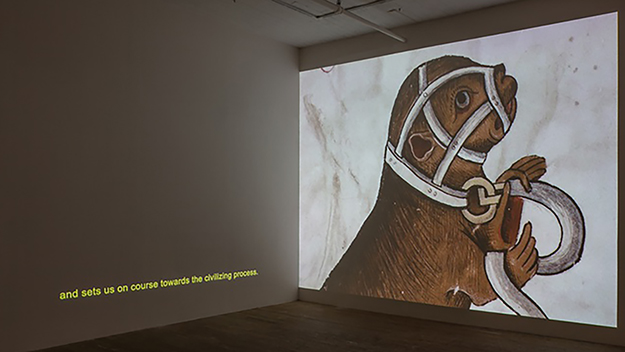Review: Mary Helena Clark’s Conveyor
This article appeared in the March 15, 2024 edition of The Film Comment Letter, our free weekly newsletter featuring original film criticism and writing. Sign up for the Letter here.

Installation view of Neighboring Animals (Mary Helena Clark, 2024). Photo: Gregory Carideo. Courtesy of Bridget Donahue Gallery.
Over the last decade, a tendency has appeared within the field of “artists’ moving image” that might be called “writers’ moving image.” Across festivals and gallery spaces, language, whether as text or speech, is found time and again layered atop montage-based work. Within this subset, Mary Helena Clark is exemplary, if atypical: her words serve to complicate her pictures, in contrast to the more common approach of using language to close down the available meaning of images in the name of discursive certainty. The experience of watching Clark’s films abounds in moments of being drawn along by glimmers of coherence between picture and text, by conceptual and emotional harmonies humming just out of sight. It’s fitting then that thresholds—doors, windows, walls, and most importantly mouths—play key roles in Clark’s first solo gallery show in New York, Conveyor, at Bridget Donahue through March 23.
Entering the first room, one encounters Monitors, a parallel pair of hollow steel doors, their exposed interiors fitted with speakers emitting faint field recordings of spectators at a zoo. On the surrounding walls are six photographs from the Brooders series, each showing a cardboard incubator (five are empty, one holds a handful of eggs); in the two most compelling, the frame of the image aligns with the frame of the box, rendering these spaces of care as closed worlds. Meanwhile, on the floor, the Drivers—three dead bolts fitted with motors continuously locking and unlocking it—flop pathetically.
Taken together, these installations do not resolve to a point or statement. Rather, by courting our empathy in their own distinct ways, they raise questions about how we are to care for, and relate to, what doesn’t have the language to speak to us. These questions are deepened and expanded in the subsequent room by a two-channel video, Neighboring Animals. Projected on perpendicular walls, its images and words reside on separate channels. The text—quotations (by the likes of Freud and Dickinson) and original writing constellated around the mouth as a site of violence and communication—appears as yellow subtitles at the bottom of an otherwise blank frame, becoming a kind of mouth itself: open and ready to swallow the neighboring pictures, a move that both highlights and troubles language’s capacity to caption and clarify.
The images comprise a few general themes: veterinary scenes, including medieval illustrations and contemporary footage; analyses of bite marks; various decorative eggs; human medical footage (all of it dealing with the mouth and throat); and instances of the supernatural, ranging from a magic trick involving an orangutan to a sacred relic—a tooth of Mary Magdalene’s—housed at the Met. As we see an X-ray of a swallowing throat, the text reads: “My mother tells a story about a decorative egg. —The most beautiful thing I’d ever seen and the only way my pea-sized brain could think to make it mine was to take a bite.” Beauty leads to base desire, and the obscure relay between two prime sites of linguistic communication—brain and mouth—breaks down, revealing language as an illusion which tricks humanity into conceiving itself as other than animal. That recognition constitutes a kind of ethics, a careful way to live.
Phil Coldiron is a writer living in New York.







